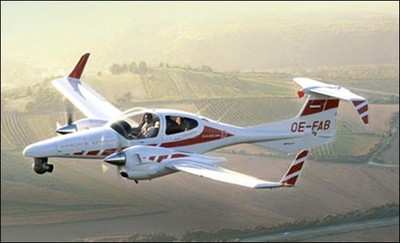Fri, Aug 14, 2009
OPV DA42 Endurance Increases To 26 Hours In Autonomous
Mode
 Almost all of us got into flying
because, well, we like to physically fly the airplane. But there
has been a great deal of news recently about aircraft for which the
pilot is (at least in this case) optional. Aurora Flight Sciences
Wednesday announced the launch of an Optionally Piloted Vehicle
(OPV) based on the popular Diamond Aircraft DA42M. The DA42M is a
European Aviation Safety Agency (EASA) certified twin-engine
aircraft that seats four people. Its diesel engines run on a range
of heavy fuels. It is made in Austria by Diamond Aircraft
Industries. In July 2009, Diamond Aircraft received Federal
Aviation Administration (FAA) Certification for the Austro Engine
AE300 Powerplant. The FAA certification of the Austro AE300 engine
paves the way for FAA validation of the EASA Type Certificate for
the DA42 NextGen configuration. FAA validation is expected late
third quarter 2009. Diamond's DA42 NG averages a fuel burn of only
5.6 gph per engine, at 65% power and 155 kts at 14,000 feet.
Almost all of us got into flying
because, well, we like to physically fly the airplane. But there
has been a great deal of news recently about aircraft for which the
pilot is (at least in this case) optional. Aurora Flight Sciences
Wednesday announced the launch of an Optionally Piloted Vehicle
(OPV) based on the popular Diamond Aircraft DA42M. The DA42M is a
European Aviation Safety Agency (EASA) certified twin-engine
aircraft that seats four people. Its diesel engines run on a range
of heavy fuels. It is made in Austria by Diamond Aircraft
Industries. In July 2009, Diamond Aircraft received Federal
Aviation Administration (FAA) Certification for the Austro Engine
AE300 Powerplant. The FAA certification of the Austro AE300 engine
paves the way for FAA validation of the EASA Type Certificate for
the DA42 NextGen configuration. FAA validation is expected late
third quarter 2009. Diamond's DA42 NG averages a fuel burn of only
5.6 gph per engine, at 65% power and 155 kts at 14,000 feet.
"Performance of the basic DA42M is impressive," said Aurora
President John Langford. "With two people it has an endurance of 17
hours. With pilots removed in the OPV configuration, performance is
even better. With 100 pounds of payload, the DA42M-OPV will have an
endurance of 26 hours or a radius of 1000 nm. Its turbocharged
engines are certified for operations up to 18,000 feet and have
performed at altitudes above 25,000 feet."
The OPV concept is intended to combine the best of manned and
unmanned aircraft capabilities. In its manned mode, the DA42M-OPV
will retain its EASA certification and can be flown by any pilot
licensed to fly the standard DA42. This is ideal for ferry
operations, pilot proficiency, and for operation within the
National Airspace System or other controlled environments. In cases
where extended performance is needed, or where operations are too
dangerous for manned aircraft, the unmanned mode is activated and
the aircraft can be operated from a remote ground control station.
The OPV system will be compatible with NATO STANAG 4586, making it
compatible with other existing unmanned systems. The ground control
equipment is sufficiently compact to fit within the existing DA42M
cargo space and can be ferried within the aircraft to remote
destinations.

DA42M-OPV
The avionics and flight control system for the DA42M-OPV is
being developed and tested by Aurora using company owned aircraft.
Aurora's track record with advanced flight control systems for UAVs
dates back more than two decades across a large range of Aurora
developed UAVs.
The DA42M-OPV will be available for delivery in the third
quarter of 2010, subject to customer orders. Aurora is currently in
discussion with several potential launch customers.
More News
“Honored to accept this mission. Time to take over space. Let’s launch.” Source: SecTrans Sean Duffy commenting after President Donald Trump appointed U.S. Secret>[...]
Permanent Echo Radar signals reflected from fixed objects on the earth's surface; e.g., buildings, towers, terrain. Permanent echoes are distinguished from “ground clutter&rd>[...]
Aero Linx: European Hang Gliding and Paragliding Union (EHPU) The general aim of the EHPU is to promote and protect hang gliding and paragliding in Europe. In order to achieve this>[...]
Glider Encountered A Loss Of Lift And There Was Not Sufficient Altitude To Reach The Airport Analysis: The flight instructor reported that while turning final, the glider encounter>[...]
Airplane Climbed To 100 Ft Above Ground Level, At Which Time The Airplane Experienced A Total Loss Of Engine Power On May 24, 2025, at 1300 eastern daylight time, an Aeronca 7AC, N>[...]
 Aero-News: Quote of the Day (07.11.25)
Aero-News: Quote of the Day (07.11.25) ANN's Daily Aero-Term (07.11.25): Permanent Echo
ANN's Daily Aero-Term (07.11.25): Permanent Echo ANN's Daily Aero-Linx (07.11.25)
ANN's Daily Aero-Linx (07.11.25) NTSB Final Report: Schweizer SGS 2-33A
NTSB Final Report: Schweizer SGS 2-33A NTSB Prelim: Aeronca 7AC
NTSB Prelim: Aeronca 7AC




